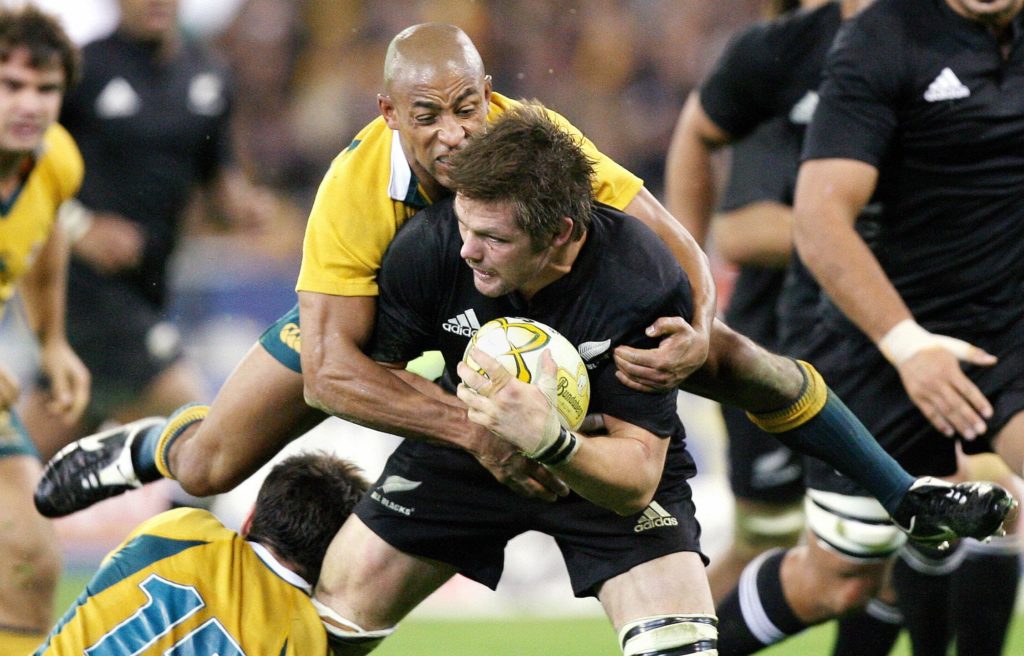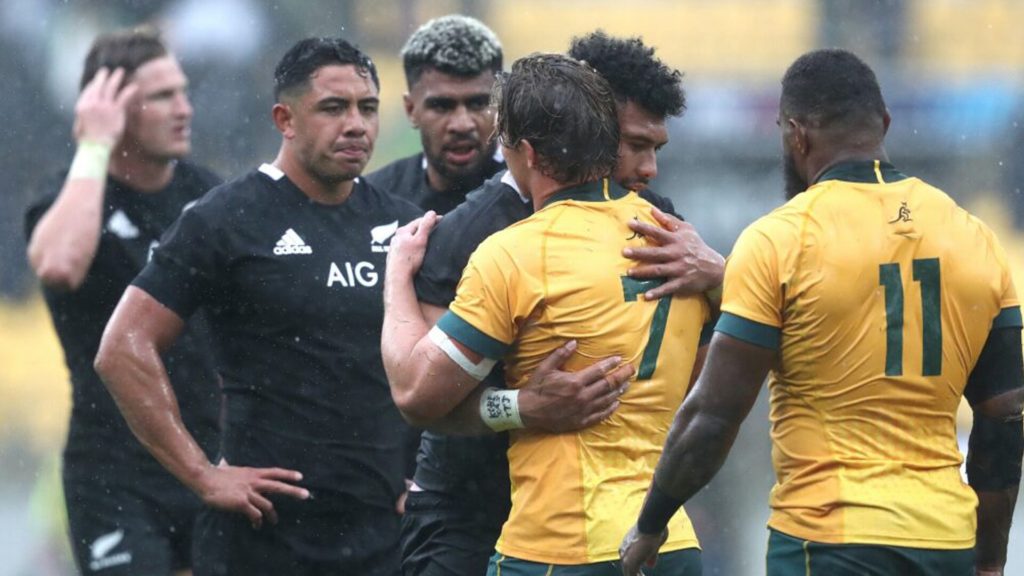I remember well the time George Gregan finally broke me.
It had been about seven years in the making and it happened during a horrible, wet and cold test in Wellington.
We were good mates then of course, and are still, despite being typicallycompetitive halfbacks at constant loggerheads at the highest level.
The thing is, George liked to talk his way around a rugby field. He would narrate every breakdown and call out every opposition player’s transgression – real or imagined.
It’s funny when you think about it because I was the one who would later get the job as a television commentator but with George it was a way of telling the referee exactly what the issues were and exactly why the Wallabies were being wronged; which was most of the time if not all of it.
When there is a constant stream of commentary along the lines of: “they’re offside, he’s off his feet, he’s not releasing”, it has the dual effect of reminding players they may be in the wrong and reminding referees they are under intense scrutiny.
It also gets under opposing players’ skins. It certainly did mine. George knew all of this of course and had honed his strategy to increasingly annoying perfection.
Anyway, during this test in Wellington, George shouted something about an All Black forward at a breakdown and, what do you know, the Wallabies were awarded a penalty. “Yes, yes, yes!” he said to the ref, along with the classic “he’s been doing it all day!”.

That was it for me. I broke, and said “George, would you shut the f*** up”. It was the worst thing I could do. “Oh Marshy”, he said. “What’s wrong mate? Are you upset mate? Look boys, Marshy’s upset!” Suitably encouraged, the commentary then resumed louder and longer than ever.
People have often asked how we became such good mates and it’s no secret – we had a lot in common and we saw a lot of each other.
We first met at under-19 level and that continued when we played for the New Zealand and Australia under-21s, also known as colts.
Back in the early 90s if you were lucky enough to make the New Zealand under-19s or colts, the only international side you faced was Australia, and the same was true for the Aussie guys – they’d only play us.
It also gets under opposing players’ skins. It certainly did mine. George knew all of this of course and had honed his strategy to increasingly annoying perfection.
Now the under-20s play against all the world’s rugby nations via their World Cup but back in my day it was very different. So we mixed a lot with the Aussies and I with George, who even as an 18- and 19-year-old was ultra competitive, although back then he was rocking an afro then rather than the shaved dome he has now.
I remember playing against George in a curtain-raiser to an All Blacks versus Wallabies test at Carisbrook in Dunedin and all four teams came together at the test dinner afterwards.
We don’t have test dinners any more but back then they were a big part of the test experience. It was a carry over from the amateur days, but, due to late kick-offs and the various recovery protocols players now follow, they have been kicked into touch.
George and I were obviously rivals but we had a mutual respect. At that dinner in Dunedin we chatted and had a few beers. That continued into our colts days and in the end we had a good group of guys that got on well together; George, Matt Burke, Rod Kafer and Joe Roff along with myself, Andrew Mehrtens and Tabai Matson. We’d all go on to be Wallabies and All Blacks.
George had only one year with the colts before he made his test debut and that kind of inspired me. I had played against him and now I saw him running around for the Wallabies and making that famous tackle on Jeff Wilson in that Bledisloe Cup match in Sydney in 1994.

I knew if I worked hard maybe getting to that level was something I could achieve too. His progress was slightly quicker than mine and that forced me to improve and follow him. A year later, in 1995, I did.
In the mid to late 90s there was a similar dynamic age-and experience-wise in the All Blacks and Wallabies. There was a group of guys coming through, like George and I, and a group of older guys coming to the end of their careers. As an example in the All Blacks, Sean Fitzpatrick, who retired in 1997, is 10 years older than me. In the Wallabies, Michael Lynagh and David Campese are a decade older than George.
In some ways, us young guys had more in common with each other than our some of our older teammates, but in saying that, I wasn’t aware of any cliques in the All Blacks.
We might have played computer games while the older guys played cards or backgammon. But while we used to play cricket in hotel corridors guys such as Fitzy and Zinzan Brooke may not have been involved initially, they would soon join in if they were walking past. Today if I were to travel to the United Kingdom, Fitzy is one of the first people I’d contact.
So George and guys like Matt Burke and I got so comfortable in each other’s company we’d spend a lot of time together, so much so that during a test week in Christchurch I played a round of golf with them and hosted them at a barbeque at my home in the days before the match. Needless to say, that’s almost unheard of now.
I’m writing this now at Auckland airport on my way to Sydney for Bledisloe III and already we have formed a Whatsapp group consisting of Phil Waugh, Phil Kearns, Kafer and Mehrts.
So George and guys like Matt Burke and I got so comfortable in each other’s company we’d spend a lot of time together, so much so that during a test week in Christchurch I played a round of golf with them and hosted them at a barbeque at my home in the days before the match. Needless to say, that’s almost unheard of now.
We’ll meet up for a few beers and a few laughs because we were lucky enough to play in a time when those friendships could be formed and galvanised. I’m not sure that happens now and the game is poorer for it, although I was pleased to see the Wallabies spend time in the All Blacks’ changing room after the drawn Bledisloe I test in Wellington recently.
Sometimes that intense rivalry and competitiveness can be detrimental to friendships, but that never happened to us guys – George and I in particular – and I hope it doesn’t happen to the New Zealand versus Australia rugby dynamic in general.
Australia are our closest allies – we’re Anzacs, after all. We appreciate similar things and we’re both overachievers on the world sporting stage. We’re battlers and just because other nations may have more numbers or resources, that doesn’t affect the Anzac spirt.
Things are said and done on the field but they’re generally left there and that’s what makes rugby so special. The camaraderie in Wellington after an extremely hard-fought test this year is a reminder of that.
What set George apart was his competitiveness and his search for perfection and he’s like that away from the pitch too, whether it’s playing golf or cooking a barbeque.
He analyses golf and plays to a low handicap. He pushes himself hard on the course. As for the barbeque, the chicken on the grill has to be perfect – not dry – and accompanied with the right spices and other ingredients.

On the pitch he was very driven – whether it was for the Brumbies, Toulon or Australia. That, combined with his excellent core skillset, was why he played 139 tests and had such longevity in the game – 14 years at the top level.
I remember the day in 2007 when he announced his retirement. I thought it would never come.
We played a different style, he and I. George was a great manipulator of defences and was superb at putting players into space – his synergy with Owen Finegan was excellent.
He was a very good support runner too, and a good lateral defender. He got to an endless number of breakdowns and was faultless – he hardly made an error.
When I think about our great mate Joost van der Westhuizen, the Springboks halfback sadly no longer with us, Joost could have an off day but within the space of a few seconds he could break you apart and score a try from nowhere.
He could step out of a ruck and put up a chip kick and score from it. With George you got the same every time.
If I was asked to describe my own style, I’d say I was somewhere in the middle of those two. I was a bit more combative and was happy to carry the ball – I liked to challenge defenders myself.
I could also have quieter games – something a very vocal George Gregan could never be accused of having.
He was an annoying pest as an opponent while simultaneously being one of my best mates, and, at the highest level of sport, that’s a pretty unique and special thing, I reckon.
In the spirit of all those years ago in Dunedin when we were still teenagers with our professional rugby careers ahead of us, here’s to being able to knock each other about for 80 minutes and meet up for a beer straight afterwards.
Here’s to rugby, here’s to the Bledisloe Cup, and yes, here’s to you, George.


Comments
Join free and tell us what you really think!
Sign up for free